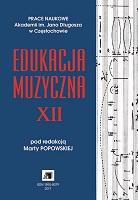Kwartety smyczkowe Władysława Żeleńskiego
String Quartets by Władysław Żeleński
Author(s): Maryla RenatSubject(s): Music
Published by: Uniwersytet Jana Długosza w Częstochowie
Keywords: string quartet; Polish chamber music of 19th century; Władysław Żeleński
Summary/Abstract: The main aim of the article is to present the works for string quartet of the Polish composer Władysław Żeleński (1837–1921) in the context of his biography. The part of the composer’s output discussed herein includes the following works: 1. Variations on an Original Theme in G Minor, Op. 21 (1869); 2. String Quartet in F major, Op. 28 (1875); 3. String Quartet in A major, Op. 42 (after 1880). Two phases can be distinguished in dealing with this issue. The first concerns the outline of the state of the literature on the subject, existing only in the Polish language, poor and usually limited to general stylistic-critical comments, which are not always correct. There are no papers that discuss in detail and in a comprehensive way all the music pieces belonging to Żeleński’s chamber works. This paper is therefore the first attempt in this respect. The second phase concerns the musical analysis, as a result of which the following are discussed: form, compositional technique, expressive aspect and reception. The multifaceted analysis was carried out partly by referring to Nicolas Cooke’s concept and using the comparative analysis. Żeleński’s compositions for string quartet are dominated by the lyrical category of expression. The key role is played by texture, in which the interaction of instruments is constantly changing within mutual relations. Another feature that deserves attention are references to Polish folk music. This is reflected in the use of the characteristic Lydian fourths and drone fifths. Moreover, the composer introduces stylizations of the non-Polish dances, siciliana and tarantella, which occurs in Variations on the original theme, Op. 21. Harmony plays a minor role in shaping the narration. It does not contain any innovative solutions, especially in the first two works. The compositional technique evolved between the quartets in F major, Op. 28 and A major, Op. 42, which resulted, in the second composition, in a deeper development of the major-minor harmonics, a fairly diversified texture and the introduction of virtuoso parts. Żeleński's string quartets’ style represents the Classicizing style. It is a synthesis of the Classicist forms with a Neo-Romantic shaping of the musical narrative. Żeleński's compositions for string quartet represent a high artistic value, laying at the same time the foundations for Polish chamber music in the second half of the 19th century.
Journal: Edukacja Muzyczna
- Issue Year: 2017
- Issue No: 12
- Page Range: 9-51
- Page Count: 43
- Language: Polish

